The Mexican Community of Forest Hill, Louisiana
Secular Celebrations
A number of secular celebrations also take place within the Hispanic community. Several of these ceremonies serve as rites of passage, such as baptisms, quinceañeras, and weddings. Other celebrations, such as Mexican Independence Day, are institutional holidays that allow community members to maintain connections to Mexico and bind members to each other. In addition to these celebrations, members of the community get together with their families and close friends for parties where they eat traditional foods and listen to music from Mexico.
Quinceañeras
The quinceañera is a rite of passage ceremony. It marks the transition of 15 year old girls into womanhood and emphasizes their new relationship and obligations to family and church as adults. Quinceañeras are somewhat akin to “Sweet 16” parties in the United States, but with the addition of a religious component. Quinceañeras therefore begin with a thanksgiving mass, known as a misa de acción de gracias, that includes parents, godparents, and a court of several young girls. Due to the importance of this tradition, girls dress up in their finest dresses, and often wear one purchased specifically for this occasion.
Following mass there is a reception where food is served. After the meal, the band starts up and dancing begins. Some quinceañera parties may have as many as 200 people in attendance. Bands from Houston are also often hired to play at these events.
Mexican Independence Day
El Día de Independencia (Mexican Independence Day) is celebrated on September 15th and 16th. On September 16th, 1810, Father Hidalgo, a parish priest in the village of Dolores (now known as Dolores Hidalgo) called for independence from Spain in a speech that came to be known as El Grito de Independencia (The Cry for Independence). “El Grito” (The Cry) is reenacted each year on the evening of September 15th in every Mexican town. The community of Forest Hill, as all over Mexico, comes together to celebrate Independence Day with a mass and a fiesta. Following mass in 2006, the celebration moved to the open field next to the church where they unfurled the Mexican flag and celebrated their heritage as a community. The following day, September 16th, is an official holiday in Mexico and festivities also take place throughout the day.
Día de la Madres (Mothers Day)
Due to the importance of the mother in Mexican culture, and the close association of the Virgin Mary with this day, Día de la Madres (Mother’s Day) is an especially significant holiday. Mothers Day is celebrated on May 10th each year in Mexico. In Forest Hill, however, the community celebrates on the official day set aside for it in the United States (the second Sunday in May), which fell on May 13th this year. Mothers are traditionally serenaded with a song called Las Mañanitas (Little Mornings) when they awaken. Schools also often provide entertainment for the Mothers of students and it is the one day of the year when they are not expected to cook for the family.
Mothers Day is celebrated by many members of the community at the Forest Hill Catholic church. The ceremony this year was led by two nuns, one of whom is from Zacatecas and the other from Jalisco. The celebration was scheduled to begin at 5:00 pm with a mass that was attended by some 50 people (Fig. 16). The mass was led by one of the sisters, while a young girl read the prayers. During the mass the congregation said the rosary (velorio) and Ave Marias. In between prayers they sang songs accompanied by the two sisters on guitar. At the close of mass, the sisters asked that the Mother’s be allowed to leave first with their children, and that they seat themselves at the tables set up outside in the open field next to the church (Fig. 17). As the Mothers sat down a young girl came by and handed each one a flower.
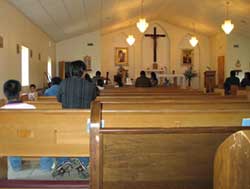
Figure 16-Mothers Day was celebrated by many at the Catholic Church in Forest Hill. Before the entertainment and festivities began, however, mass was held in the church and led by two nuns originally from Mexico.
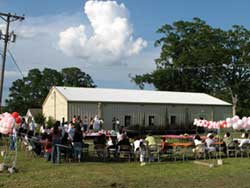
Figure 17-Following the mass, all the Mothers in attendance walked outside and seated themselves around tables set up in an open field next to the church. A young girl then came by and presented each Mother with a flower. While the Mothers sit and talk one of the nuns can be seen on the stage preparing to start the entertainment.
When the Mothers were all seated they were serenaded by children singing Las Mañanitas (Fig. 18). In addition to Mothers Day, las mañanitas is also sung on birthdays and the feast day of one’s saint. After the children finished singing, one of the Sisters walked to the microphone and explained the history of Mothers Day. When she finished, a large group of children walked up to the stage and sang to the assembled Mothers. This was followed by a group of five girls who danced to a popular musical genre called cumbia, which originated in the country of Columbia (Fig. 19). The Mothers were then entertained by seven little girls dressed as ballerinas who pirouetted around a large pink box (Fig. 20). At the conclusion of the dance a little boy wearing a multi-colored wig popped-out of the box to the delight of all the children (Fig. 21).
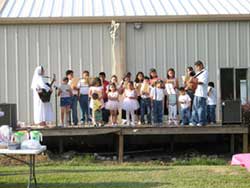
Figure 18-The Mothers Day Celebration began with the singing of Las Mañanitas (Little Mornings) a song traditionally sung to Mothers when they awaken. Fernando Canada, playing guitar along the right side of the stage, helped to provide accompaniment for the children.
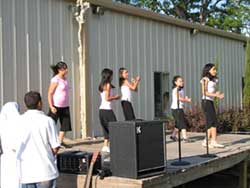
Figure 19-A small dance troupe consisting of five girls performed a dance for the Mothers to the rhythms of cumbia music that originated in Columbia.
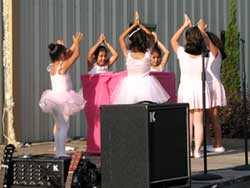
Figure 20-Seven little girls wearing pink dressed pirouette around a large pink box placed at the center of the stage.
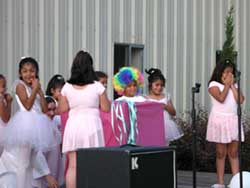
Figure 21-When the seven little ballerinas finished their dance around the pink box, a boy wearing a brightly-colored wig jumped from the box to the surprise and delight of the children.
When the children finished their dance, the sister asked ten Mothers to voluntarily come forward to take part in a game of musical chairs (Fig. 22). Ten chairs were set up in the open space in front of the stage. Whoever stood standing after the music stopped was told to walk up to a table set up in front of the stage and presented a gift for their participation. They later played another version of musical chairs using a New York Yankees baseball cap that was passed from Mother to Mother as the music played (Fig. 23). Whoever was wearing the baseball cap when the music was turned off was eliminated from the game. As in the previous game, each participant was awarded a prize.
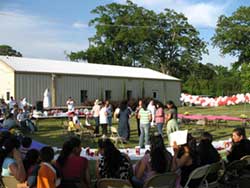
Figure 22-Mid-way through the Mothers Day Celebration, the Sister asked ten mothers to step forward to partake in a game of Musical chairs. Each person left standing after the music stop was awarded a gift for taking part in the game.
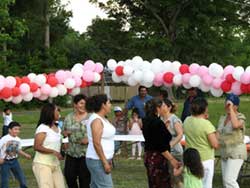
Figure 23-Seven Mothers take part in a game similar to musical chairs. Each Mother placed a baseball cap on the head of the woman in front of her. Whoever had the hat on her head when the music stopped was eliminated from the game.
Toward the end of the evening, the Mothers were served a small three-course meal. The first course consisted of a deep fried corn tortilla with a small salad placed on top. This was followed by a hot dog and a scoop of vanilla ice cream with cookies inserted into it. As the Mothers ate, twelve children walked up to the stage, one at a time, carrying a cardboard flower with a letter placed in the center. Together the letters spelled out the phrase, “Te Quiero Mama” (I Love You Mama) (Fig. 24). As each child walked up to the stage, one of the sisters associated each letter with a positive quality about the Mothers and Motherhood. The entertainment ended when two teenagers, dressed to represent the Virgin Mary and Jesus, walked up to the stage. The teenager representing Jesus recited a poem from memory titled “Carta de Jesús a su Mama en el día de las Madres” (A Letter from Jesus to His Mama on Mother’s Day) (Fig. 25).
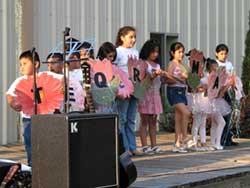
Figure 24-To honor the Mothers, twelve children walked onstage one at a time carrying a cardboard flower bearing a letter. The Sister used that letter to begin a word describing the special qualities of Mothers. When all the children had assembled, the letters spelled out: “Te Quiero Mama” (I Love You Mama).
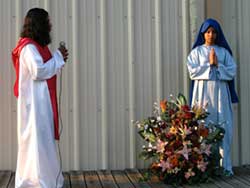
Figure 25-The Mothers Day Celebration ended when two young people, one dressed as Jesus and the other as His Mother Mary, walked to the stage. The young girl representing Mary was dressed in blue and had hands raised in prayer. The young boy portraying Jesus, recited a poem to his Mother titled, “Carta de Jesús a su Mama en el día de las Madres” (A Letter from Jesus to His Mama on Mother’s Day).
Location of Fiestas
The Mexican community holds celebrations at several different locations in and around Forest Hill. Some events are held at a small hall located next to the Catholic Church or in the open field beside the church. This includes secular celebrations, such as Mothers Day, as they also often contain a religious component. Major celebrations are also sometimes held at the former Forest Hill Academy gymnasium. This property is now owned by the city of Forest Hill which rents the gym for important events.
More recently, members of the community have held fiestas at the Woodmen of the World, a private park where they rent pavilions for their celebrations. Several workers stated that they began to hold celebrations there because they have more space and do not have to worry about bothering neighbors with loud music. In addition to these locations, Irma Rodriguez sometimes rents out her restaurant for quinceañeras and wedding celebrations.
Some of the nurseries also hold fiestas for their workers. According to Ramon Vargas, these celebrations usually occur at the end of May, “when the hard work is done” and in December before workers head home to Mexico. As a part of these fiestas, each person brings a dish to the party, similar to a pot luck dinner.
Charreada (Mexican Rodeo)
A number of migrants are aficionados of Mexican rodeo (charreada). Some workers drive to Houston to see the charreada at San Miguel Coliseum. They typically attend on Sunday, which is the day off for most workers. Fernando Martínez of Doug Young Nursery said he and his friends try to get together for a rodeo every two to three months, whenever they have free time. They rent a place in Alexandria where they put on horse riding contests, roping events, such as tossing the lariat, and “grab the bull’s tail.” Due to their work schedule, he said, they often set up rodeos when they have a three day weekend, such as on the fourth of July.